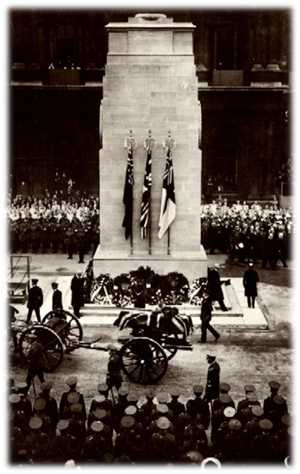
On 11th November each year we remember the War Dead at the Cenotaph which represents those soldiers who did not return home when World War One the Great War ended.
The Reverend David Railton M.C. (1884-1955) in 1914 was a Curate at the Parish Church of St Mary & St Eanswythe in Folkestone, he joined up becoming a chaplain an Army Chaplain on the Western Front in the 2nd Battalion of the Hon. Artillery Company during the 1914-18 war. In 1916 he was awarded the Military Cross for saving several men under heavy fire. One evening in 1916, in a back garden at Erkingham near Armentières in France, he noticed a grave upon which was a rough wooden cross on which were pencilled the words 'An Unknown British Soldier of The Black Watch'.
This simple message on the grave of this Unknown Warrior would disturb him for the rest of the war. Who was he and who were his parents? He wrote that he wanted to ease the pain of the father, mother, sister, sweetheart, wife and friend?
After the war he became vicar of Margate in Kent and in August 1920. He wrote to Herbert Ryle, Dean of Westminster, suggesting a permanent memorial to the fallen of the Great War who had no known grave. Reverend Davis Railton idea was that an unidentified body could be repatriated from the battlefields in France and Flanders to lie in the heart of London to represent the British Empire’s one million dead, and especially those whose bodies were not located or identified.
The Unknown Warrior was one of four unknown bodies disinterred in from the battlefields of the Aisne, the Somme, Arras and Ypres. They were taken to St Pol and one was blindly selected to return to Britain. This warrior was transported across France to Boulogne and onto HMS Verdun. The ship landed at Dover and the coffin was transferred to a Railway wagon to transfer the body of the Unknown Soldier to London which arrived at platform 8 in Victoria Station at 8.32 on 10th November 1920. This Railway wagon that was used for bringing the remains of the Unknown Warrior to London to be buried in Westminster Abbey in November 1920. The wagon has recently been restored and was in Folkestone harbour and was put on show to the public till 28th October 2018.
The same carriage had been used to bring back the body of Edith Cavell a British-born nurse was executed by a German firing squad in Brussels in 1915 for helping Allied prisoners escape their German captors during World War I. Cavell's body was brought back to England after the war. Her funeral took place in Westminster Abbey on May 15, 1919, and she was buried in Norfolk, near where she had been born.
Once again the same carriage has been used on 8th July 1919 to bring back the body of Captain Charles Algernon Fryatt. When the Germans captured his ship SS Brussels, Captain Fryatt was put on trial for attempting to try to ram and sink the German submarine U33 which was forced to crash-dive on 28th March 1915, when he was in command of the British steamship Wrexham. After his on trial in Bruges, Belgium he was immediately executed on 27th July 1916. Captain Charles Fryatt body was buried in Bruges, and was exhumed 1919, and repatriated to the UK. His body was landed at Dover and transported to London in South Eastern and Chatham Railway PMV No.132. After a funeral service at St Pauls Cathedral on 8 July 1919, he was buried at All Saints Church, Upper Dovercourt, Essex.
